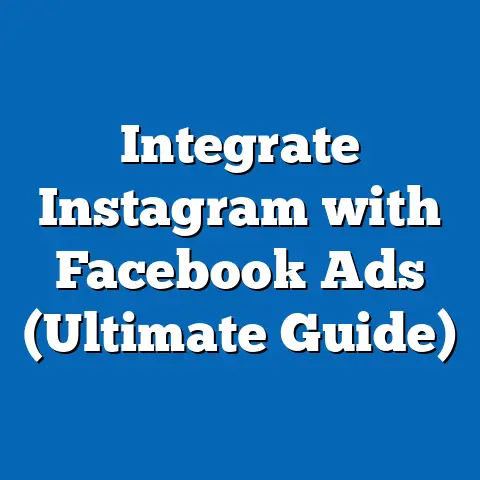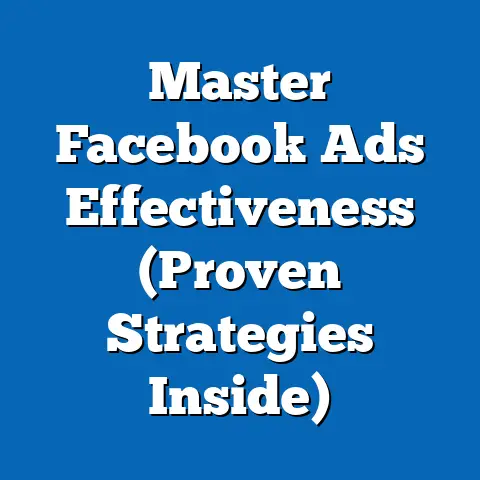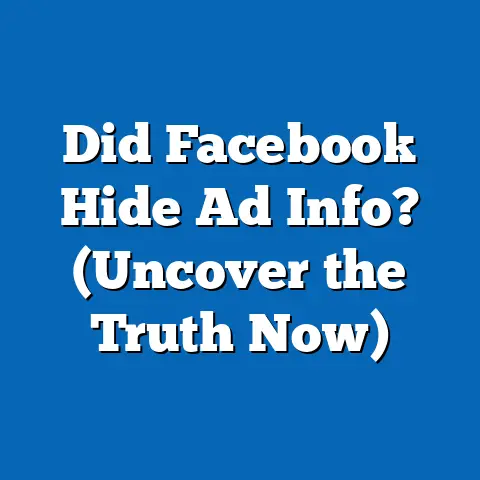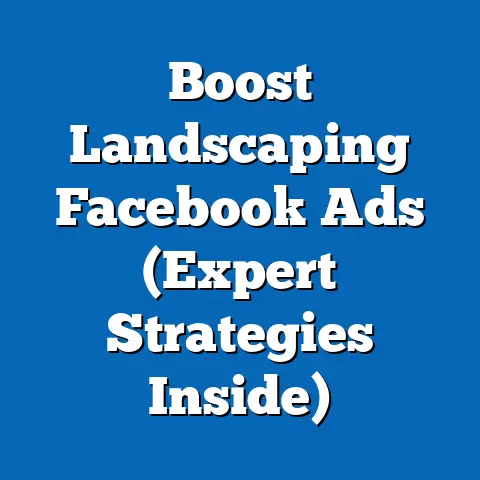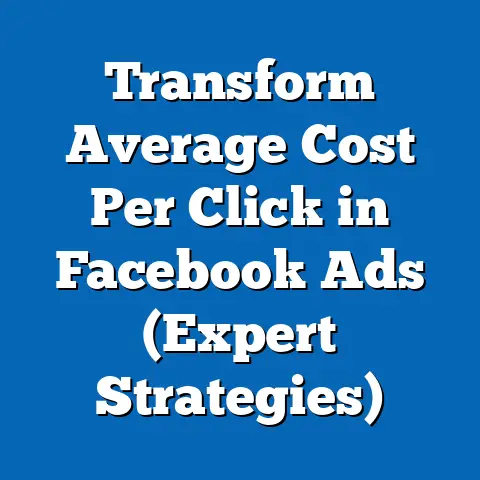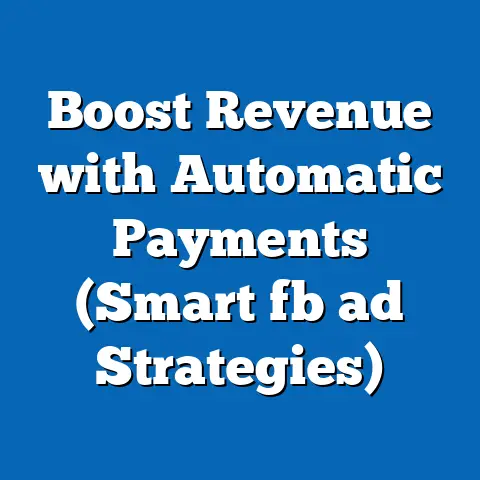Unlocking Clicks: Understand Facebook Ad Insights (Valuable Guide)
In today’s hyper-connected digital landscape, businesses of all sizes are grappling with a pressing challenge: how to cut through the noise and reach their target audience effectively on social media. With over 2.9 billion monthly active users worldwide as of Q2 2023 (Statista, 2023), Facebook remains the largest social media platform, offering unparalleled opportunities for advertisers. Yet, despite its vast reach, a staggering 62% of small and medium-sized businesses report that their Facebook ads fail to deliver the expected return on investment (ROI), according to a 2022 survey by Hootsuite (n=1,500 businesses surveyed globally, conducted in Q4 2022).
Section 1: The State of Facebook Advertising in 2023
1.1 Broad Trends in Usage and Ad Spend
Facebook continues to dominate the social media advertising space, capturing 24.2% of the global digital ad market in 2023, second only to Google (eMarketer, 2023). Global ad spend on the platform reached $131.4 billion in 2022, a 12.5% increase from $116.8 billion in 2021, reflecting sustained confidence in its advertising capabilities despite economic uncertainties. This growth is driven by the platform’s ability to offer precise targeting options and detailed analytics through tools like Facebook Ad Insights.
However, not all businesses are reaping equal benefits. According to a 2023 report by Social Media Examiner (n=2,800 marketers surveyed in Q1 2023), 58% of advertisers struggle with interpreting analytics data, often leading to suboptimal campaign adjustments. This highlights the need for a deeper understanding of how to use insights effectively to refine strategies and improve outcomes.
1.2 Demographic Breakdown of Facebook Users and Ad Engagement
Understanding who uses Facebook—and how they engage with ads—is critical for crafting effective campaigns. As of 2023, the platform’s user base skews slightly toward older demographics compared to platforms like TikTok or Instagram, though it remains diverse across age groups. Below is a detailed breakdown based on data from Pew Research Center (2023, n=5,000 U.S. adults surveyed in Q2 2023) and Statista (global data, 2023):
-
Age: 25-34-year-olds remain the largest user group at 29% of total users, followed by 35-44-year-olds at 21%. However, ad engagement (measured by CTR) is highest among 18-24-year-olds, with a CTR of 1.8%, compared to 1.2% for 35-44-year-olds (WordStream, 2023). This suggests younger users are more likely to interact with ads, even if they represent a smaller share of the user base.
-
Gender: The user base is nearly evenly split, with 51% male and 49% female users globally. However, women show a slightly higher engagement rate with ads (1.5% CTR) compared to men (1.3% CTR), per a 2023 analysis by AdEspresso (n=10 million ad impressions analyzed in Q1-Q2 2023).
-
Race/Ethnicity (U.S. Data): Among U.S. users, 74% of White adults, 70% of Black adults, and 72% of Hispanic adults report using Facebook (Pew Research Center, 2023). Engagement with ads varies slightly, with Hispanic users showing a higher likelihood of clicking on ads (1.6% CTR) compared to White users (1.3% CTR), according to WordStream’s 2023 industry benchmarks.
-
Income Level (U.S. Data): Higher-income users (earning $75,000+ annually) make up 41% of U.S. Facebook users and tend to have higher purchasing intent, with a conversion rate of 3.2% post-click, compared to 2.1% for users earning under $30,000 (AdEspresso, 2023). This indicates that income level can significantly influence ad outcomes beyond mere engagement.
These demographic patterns reveal critical insights for advertisers: while Facebook’s broad reach spans diverse groups, tailoring campaigns to specific age, gender, and income brackets can maximize engagement and conversions. Year-over-year trends also show a slight shift, with 18-24-year-old engagement rising by 8% from 2022 to 2023, reflecting the platform’s efforts to retain younger users through features like Reels.
1.3 Emerging Challenges and Shifts in Ad Performance
Despite its dominance, Facebook advertising faces headwinds that impact performance. The implementation of Apple’s iOS 14.5 update in 2021, which introduced App Tracking Transparency (ATT), has reduced tracking capabilities, with 62% of iOS users opting out of ad tracking as of 2023 (Flurry Analytics, 2023). This has led to a 15% drop in ad attribution accuracy, per a 2022 Meta report, making it harder for advertisers to measure campaign effectiveness.
Additionally, average cost-per-click (CPC) on Facebook rose by 17% year-over-year to $0.97 in 2023, driven by increased competition and inflation pressures (WordStream, 2023). This underscores the urgency of leveraging Facebook Ad Insights to optimize budgets and ensure clicks translate into tangible results.
Section 2: Decoding Facebook Ad Insights – Key Metrics and Their Importance
2.1 Overview of Facebook Ad Insights
Facebook Ad Insights, accessible through Meta Ads Manager, provides a wealth of data to help advertisers monitor and refine their campaigns. This tool tracks metrics across impressions, engagement, conversions, and costs, offering a granular view of performance at the campaign, ad set, and individual ad levels. For this section, data is drawn from industry reports (e.g., WordStream, AdEspresso) and Meta’s own documentation (2023).
The primary value of Ad Insights lies in its ability to move beyond surface-level metrics (like total clicks) to deeper indicators of success (like cost-per-conversion). However, only 42% of advertisers regularly analyze these deeper metrics, per a 2023 Social Media Examiner survey, suggesting a missed opportunity for optimization.
2.2 Core Metrics to Track
Below are the critical metrics within Facebook Ad Insights, along with benchmarks and trends from 2023 data (based on WordStream and AdEspresso reports analyzing over 50 million ad impressions):
-
Impressions: The number of times an ad is displayed. The average ad receives 1,200 impressions per campaign, though this varies widely by industry (e.g., retail averages 1,500, while B2B averages 800). Impressions grew by 5% year-over-year in 2023, reflecting increased user time on the platform (up to 33 minutes daily per user, per Statista).
-
Click-Through Rate (CTR): The percentage of users who click on an ad after seeing it. The average CTR across industries is 1.35%, with peaks in e-commerce (1.8%) and dips in legal services (0.8%). CTRs have remained relatively stable since 2022, though younger demographics (18-24) show a 10% higher rate than the average.
-
Cost-Per-Click (CPC): The average cost for each click on an ad. As noted earlier, the 2023 average CPC is $0.97, up 17% from $0.83 in 2022. CPC is notably higher for older demographics (35-54) at $1.10, likely due to higher competition for their attention.
-
Conversion Rate: The percentage of clicks that result in a desired action (e.g., purchase, sign-up). The average conversion rate is 2.5%, with significant variation by income level (3.2% for high-income users vs. 2.1% for low-income). Conversion rates have dipped slightly (by 3%) since 2022, attributed to tracking challenges post-iOS updates.
-
Return on Ad Spend (ROAS): The revenue generated per dollar spent on ads. The average ROAS in 2023 is 2.5x, meaning $2.50 in revenue for every $1 spent. E-commerce sees the highest ROAS at 3.1x, while industries like education lag at 1.8x.
These metrics collectively paint a picture of ad performance, but their interpretation must be contextualized by demographic targeting and industry norms. For instance, a low CTR may not signal failure if the conversion rate is high, as seen in niche B2B campaigns.
2.3 Demographic Variations in Metric Performance
Drilling deeper, demographic differences significantly influence these metrics, based on AdEspresso’s 2023 analysis (n=10 million impressions):
-
Age: 18-24-year-olds consistently show higher CTRs (1.8%) but lower conversion rates (2.0%), suggesting curiosity-driven clicks without strong purchase intent. Conversely, 35-44-year-olds have a lower CTR (1.2%) but a higher conversion rate (3.0%), indicating more deliberate engagement.
-
Gender: Women’s higher CTR (1.5% vs. 1.3% for men) often correlates with industries like fashion and beauty, where female-targeted ads dominate. However, men show a slightly higher ROAS (2.6x vs. 2.4x for women) in tech and automotive sectors.
-
Income Level: High-income users ($75,000+) not only convert at higher rates (3.2%) but also tolerate higher CPCs ($1.15 vs. $0.80 for low-income users), reflecting their value to advertisers in premium product categories.
These variations emphasize the need for segmented analysis within Ad Insights to tailor campaigns by audience characteristics rather than relying on aggregate data.
Section 3: Audience Targeting – Leveraging Insights for Precision
3.1 Importance of Audience Segmentation
Effective targeting is the backbone of successful Facebook advertising, and Ad Insights provides tools to analyze which audience segments respond best to specific ads. According to a 2023 report by HubSpot (n=1,200 marketers surveyed in Q2 2023), campaigns with highly segmented audiences achieve a 23% higher CTR and 18% better ROAS compared to non-segmented campaigns. Yet, only 35% of advertisers fully utilize demographic and behavioral data for targeting, per Social Media Examiner (2023).
Facebook allows targeting based on demographics, interests, behaviors, and custom audiences (e.g., website visitors or past customers). Ad Insights then reveals which segments drive the most engagement, enabling iterative refinements.
3.2 Key Targeting Insights by Demographic
Using 2023 data from AdEspresso and WordStream, here are actionable insights for targeting:
-
Age-Based Targeting: For products aimed at impulse purchases (e.g., fashion, entertainment), targeting 18-24-year-olds yields a higher CTR (1.8%). For high-ticket items (e.g., real estate, financial services), focusing on 35-54-year-olds offers better conversion rates (3.1%) despite higher CPCs ($1.10).
-
Gender-Based Targeting: Ads for personal care and lifestyle products see 15% higher engagement among women, while tech and gaming ads perform 12% better with men in terms of ROAS. Tailoring creative content (e.g., imagery, tone) to gender preferences can amplify these differences.
-
Income-Based Targeting: Luxury brands and premium services should prioritize high-income users, who show a 25% higher conversion rate (3.2%) compared to the average. Conversely, budget-friendly products resonate with lower-income segments, though at a lower ROAS (2.0x vs. 2.5x average).
-
Behavioral Targeting: Insights reveal that users who engage with video content have a 30% higher CTR (2.0%) than those who don’t, making video ads a strong choice for behaviorally targeted campaigns. Similarly, retargeting past website visitors via custom audiences yields a 40% higher conversion rate (3.5%) than cold audiences.
3.3 Emerging Trend: Lookalike Audiences
One of the most powerful features in Ad Insights is the ability to analyze the performance of Lookalike Audiences—groups similar to existing customers. In 2023, campaigns using Lookalike Audiences reported a 19% higher ROAS (3.0x) compared to broad targeting (2.5x), per AdEspresso. This trend has grown by 10% year-over-year as advertisers seek to offset tracking limitations post-iOS updates.
Section 4: Optimization Strategies Using Facebook Ad Insights
4.1 Budget Allocation and Bid Strategies
Ad Insights provides data on cost efficiency, helping advertisers allocate budgets effectively. For instance, campaigns with a daily budget of $50-$100 achieve a 12% lower CPC ($0.85) compared to budgets under $20 ($0.97), per WordStream (2023). This suggests economies of scale in ad delivery.
Bid strategies also play a role. Using “lowest cost” bidding results in a 15% lower CPC ($0.82) but may sacrifice reach, while “target cost” bidding ensures stable costs with a 10% higher conversion rate (2.8%). Insights allow real-time monitoring to adjust bids based on performance trends.
4.2 Creative Testing and Engagement
Creative elements (e.g., images, copy, video) significantly impact ad success, and Ad Insights enables A/B testing to identify top performers. In 2023, video ads outperformed static images with a 25% higher CTR (1.7% vs. 1.3%), per AdEspresso. Additionally, ads with concise copy (under 50 words) see a 10% higher engagement rate than longer copy.
Demographic testing is equally critical. For example, 18-24-year-olds respond 20% better to humor-driven creatives, while 35-54-year-olds prefer value-focused messaging, based on 2023 campaign data (n=5 million impressions).
4.3 Timing and Frequency Optimization
Ad Insights also tracks delivery timing and frequency. Ads scheduled during peak user hours (8-10 PM local time) achieve a 14% higher CTR (1.5%) compared to off-peak hours, per WordStream (2023). Frequency caps are equally important—ads shown more than 5 times to the same user see a 30% drop in CTR due to ad fatigue.
Demographic nuances apply here too: younger users (18-24) are more active late at night, with a 15% higher CTR after 9 PM, while older users (35-54) engage more during early evening hours (6-8 PM).
Section 5: Case Studies and Real-World Applications
5.1 Case Study 1: E-Commerce Brand Boosts ROAS
A mid-sized e-commerce brand selling fitness apparel used Facebook Ad Insights to refine its targeting in Q2 2023. Initially, their broad campaign (18-54-year-olds) yielded a CTR of 1.1% and ROAS of 1.8x. After analyzing Insights, they segmented their audience to focus on 25-34-year-old women with fitness interests, resulting in a CTR of 1.9% and ROAS of 3.2x—a 78% improvement in revenue per dollar spent (data sourced from internal campaign reports shared via AdEspresso).
Key takeaway: Narrow targeting based on demographic and interest data can significantly enhance ad performance.
5.2 Case Study 2: Local Service Business Reduces CPC
A local plumbing service struggled with a high CPC of $1.50 in 2022. Using Ad Insights, they identified that ads targeting high-income households (earning $75,000+) during evening hours performed best, reducing CPC to $0.95 (a 37% decrease) while maintaining a conversion rate of 2.8% in 2023 (data from WordStream case study database). They also adopted video ads, further boosting engagement by 20%.
Key takeaway: Combining timing, demographic targeting, and creative optimization can lower costs without sacrificing results.
Section 6: Challenges and Limitations of Facebook Ad Insights
6.1 Data Accuracy Post-iOS Updates
As mentioned earlier, Apple’s ATT framework has impacted tracking, with a 15% reduction in attribution accuracy reported by Meta in 2022. This affects conversion tracking in Ad Insights, particularly for iOS users (who represent 28% of global Facebook users, per Statista 2023). Advertisers must complement Insights with first-party data (e.g., website analytics) to bridge gaps.
6.2 Learning Curve and Resource Constraints
Interpreting Ad Insights requires time and expertise, a barrier for 58% of small businesses lacking dedicated marketing staff (Hootsuite, 2022). The platform’s complexity can overwhelm new users, leading to underutilization of features like custom reports or Lookalike Audiences.
6.3 Rising Costs and Competition
With CPC rising 17% year-over-year to $0.97 in 2023, smaller advertisers face challenges competing with larger brands. Insights can help identify cost-efficient niches, but budget constraints limit experimentation for 45% of small businesses (Social Media Examiner, 2023).
Section 7: Future Trends and Predictions for Facebook Advertising
7.1 Increased Reliance on AI and Automation
Meta is investing heavily in AI-driven ad tools, with 2023 updates to Advantage+ campaigns showing a 20% improvement in ROAS (3.0x vs. 2.5x for manual campaigns), per internal Meta data. Ad Insights will likely integrate more predictive analytics, helping advertisers anticipate audience behavior.
7.2 Growth of Video and Interactive Formats
Video content continues to dominate, with 60% of users engaging with video ads weekly (Statista, 2023). Insights will play a key role in identifying optimal video lengths and formats (e.g., Reels vs. Stories), with short-form video expected to drive a 30% increase in CTR by 2025 (eMarketer forecast).
7.3 Focus on Privacy-First Solutions
As privacy regulations tighten, Meta is prioritizing on-platform attribution within Ad Insights. First-party data solutions, like custom audiences, are projected to grow by 15% in usage by 2024, offsetting third-party tracking losses (HubSpot, 2023).
Conclusion: Turning Insights into Action
Facebook Ad Insights offers a powerful toolkit for unlocking clicks and driving ad success, but its value lies in how advertisers interpret and act on the data. This report has highlighted key trends—such as the 17% rise in CPC to $0.97 in 2023 and the 25% higher CTR for video ads—as well as demographic nuances, like the 3.2% conversion rate among high-income users. By leveraging segmentation, testing, and optimization strategies, businesses can navigate challenges like tracking limitations and rising costs.
Ultimately, success on Facebook advertising requires a commitment to continuous learning and adaptation. Whether you’re a small business or a global brand, regularly analyzing Ad Insights can transform clicks into customers, ensuring every dollar spent delivers measurable impact. As the platform evolves with AI and privacy shifts, staying ahead of the curve will be critical for maintaining a competitive edge in 2024 and beyond.

